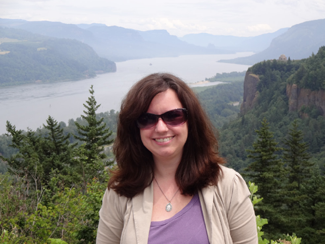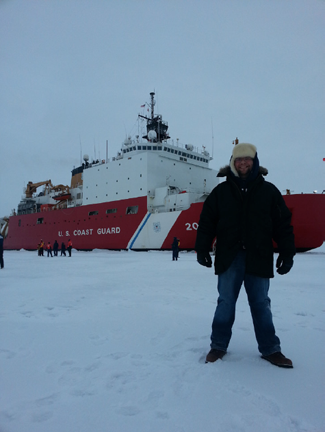
Get to Know
FHWA’s National Transportation Liaisons
The National Transportation Liaisons serve as the Federal Highway Administration’s (FHWA) connection to Federal resource and regulatory agencies, as well as facilitate coordination among these agencies and FHWA. The National Transportation Liaisons contribute expertise and perspectives to inform FHWA initiatives and programs, assist States interested in establishing resource or regulatory agency transportation liaison positions, and support FHWA Transportation Liaison Community of Practice (CoP) activities. These National Transportation Liaison activities involve providing feedback on draft materials, sharing information about liaison programs nationwide, and participating in outreach activities. The National Transportation Liaisons provide agency input on guidance that facilitates environmental streamlining, such as the Moving Ahead for Progress in the 21st Century Act (MAP-21) Q&As and the update of the 1988 handbook titled “Applying the Section 404 Permit Process to Federal-aid Highway Projects,” better known as the “Red Book.”
Field Transportation Liaisons:
Facilitating Environmental Review
of Transportation Projects at the
State Level
Field transportation liaisons help facilitate the environmental and permitting review process for transportation projects by providing technical assistance and coordinating the response of resource and regulatory agencies to State Departments of Transportation (DOTs). They often assist in the transportation planning process by providing their environmental expertise to regional transportation plans or project alternatives. State DOTs may use Federal-aid highway funding to support transportation liaisons under the authority of Federal law codified at 23 United States Code 139(j).
Transportation liaisons provide a range of benefits, including:
- Development of streamlined processes and expediting environmental reviews
- Input during planning and design to avoid environmentally sensitive areas
- More predictable environmental reviews and consultations
- Improved communication and coordination between State DOTs and resource and regulatory agencies
- Increased access to environmental and regulatory expertise for State DOTs
Transportation Liaisons are employed by the resource or regulatory agency where they serve, but their positions are funded by FHWA. There are currently four staff serving as National Transportation Liaisons:
- Lauren Diaz of the U.S. Army Corps of Engineers (USACE)
- Rachel Herbert of the U.S. Environmental Protection Agency (USEPA)
- Catherine Liller of the U.S. Fish and Wildlife Service (USFWS)
- Zachary Schulman of the U.S. Coast Guard (USCG)
The National Transportation Liaison at the Advisory Council on Historic Preservation (ACHP) retired last fall after many years of service. The ACHP is in the process of filling the position. FHWA is also currently developing a liaison agreement with the National Oceanic and Atmospheric Administration (NOAA).
USACE’s National Transportation Liaison Has Strong Connections to the Field
Lauren Diaz, the USACE National Transportation Liaison, has experience in both the public and private sectors. With a background in Marine Science and Policy Affairs, she worked at the county level reviewing permit applications for work in tidal waters and in a field office for the USACE’s Jacksonville District reviewing permit applications before becoming the National Transportation Liaison. She also worked as a permitting project manager at a private engineering and design firm prior to joining USACE. As the National Transportation Liaison, Ms. Diaz is an invaluable resource to the field on liaison agreements, guidance issued by the USACE Regulatory Program, and related questions. The USACE Regulatory Program evaluates permit applications for work within waters of the U.S., including the discharge of dredged and fill material. She holds quarterly calls among the USACE field transportation liaisons and hosts an internal SharePoint site that serves as a portal where the field liaisons can share information and communicate with one another. In addition to her interaction with the field liaisons, Ms. Diaz acts as a point of contact when FHWA engages USACE on national issues and implementation of new guidance. Being able to informally discuss FHWA’s development of MAP-21 regulations and the development of the proposed rule on defining waters of the U.S. has given Ms. Diaz a better understanding of FHWA’s perspective, which informs her work at USACE. She enjoys having the opportunity to interact with professionals all over the nation and learn about different types of projects with diverse issues and points of view.
USEPA’s National Transportation Liaison Focuses on Impacts to Water Resources

EPA’s National Transportation Liaison, Ms. Herbert, touring the Historic Columbia River Highway—America’s oldest scenic highway—outside of Portland, Oregon. (Courtesy of Rachel Herbert)
The USEPA National Transportation Liaison, Rachel Herbert, has a background in Marine Estuarine Environmental Science and Natural Resources Management. She has worked with stakeholders implementing USEPA’s Stormwater Program since 2005. Ms. Herbert finds that the key to success in her role is to understand the unique perspectives that FHWA, USEPA, and State DOTs bring to the table and find ways to link the efforts of each agency. She sees herself as a conduit for sharing information and solutions to prevent pollution and impacts to rivers, streams, and lakes. Ms. Herbert also works to coordinate with field transportation liaisons in various programs at USEPA, including Compliance and Enforcement for the National Environmental Policy Act, the Wetlands Program, the National Pollutant Discharge Elimination System Program, and the Non-Point Source Program. She identifies opportunities to coordinate with FHWA on interagency efforts, such as the newly announced Watershed Resources Registry, a watershed-based mapping tool collaboratively developed by Maryland resource and transportation agencies. A highlight of Ms. Herbert’s collaboration with FHWA was developing the joint FHWA-USEPA webcast series, which highlights the ways in which State DOTs and local agencies are reducing the impact of stormwater in their communities. The webcast series has had over 2,600 attendees to date. Ms. Herbert enjoys finding innovative solutions to prevent pollution and other negative impacts to valuable water resources and sharing them with others.
USFWS’s National Transportation Liaison Applies Diverse Experience to Improving Relationships
Catherine Liller, the USFWS National Transportation Liaison, has worked for the agency for over twelve years in various roles in the Environmental Contaminants Program, Listing Program, and Consultation Program, among others. As the National Transportation Liaison, she views her role as one of support to both USFWS biologists and FHWA in working together to achieve common goals. These goals include facilitating process improvements and efficiency and identifying research needs. She acts as the main USFWS point of contact for FHWA when coordinating policies and guidance pertaining to environmental laws and regulations. She also facilitates communication with the USFWS field transportation liaisons to share best practices and new developments in the field of road ecology. In her role as a national coordinator, she helps provide more direct access to State and Federal partners, ensures more lines of communication, and assists in maintaining the connections needed for both agencies to be successful. One prominent experience of Ms. Liller’s seven-year tenure as the USFWS National Transportation Liaison was facilitation of a Clean Water Act Section 404(q) Dispute Resolution Process regarding a mitigation bank in New Jersey. Her involvement added support to the USFWS field and regional office and provided a clearer picture on the issues and needs for each party. Open discussions and transparency in the process led to a successful resolution. Ms. Liller has had the opportunity to work across program areas within the USFWS and has made lasting relationships with both USFWS and FHWA personnel.
USCG’s National Transportation Liaison Is Increasing Transparency

Mr. Schulman standing in front of the USCG Cutter HEALY at 78 degrees north latitude in the Arctic Ocean. (Courtesy of Zachary Schulman)
Zachary Schulman is the USCG’s first National Transportation Liaison, accepting his current role in September 2014 after having worked in the agency for over two years. His background includes international affairs, geography and law, non-governmental organizations, research institutions, the private sector, and the United Nations. As the National Transportation Liaison, he works to improve communications between FHWA and USCG during the bridge permit process at the field and headquarters levels. He connects the right people at USCG field offices to the FHWA personnel seeking information on USCG policies and procedures and vice versa. He is looking forward to traveling to each USCG district office to learn about specific areas of improvement for coordination between USCG and FHWA. Additionally, Mr. Schulman facilitates implementation of the Memorandum of Agreement on research and innovation between USCG and FHWA to help increase transparency and communication in the bridge permit process. Increased coordination between the agencies ensures that important infrastructure projects will be permitted, constructed, and put into service faster and more efficiently.
National Transportation Liaisons Strengthen Interagency Ties
The National Transportation Liaisons serve as invaluable resources to FHWA in terms of building relationships with resource and regulatory agencies, providing interagency perspectives on transportation projects, serving as links to field transportation liaisons, and providing input on guidance that facilitates environmental streamlining.
Having direct links to five Federal agencies that are key partners in the environmental review process for transportation projects helps ensure transparency and open communication between transportation agencies and resource and regulatory agencies. With the establishment of National Transportation Liaison positions, FHWA has strengthened its relationships with the USACE, USEPA, USFWS, USCG, ACHP, and NOAA.
For more information on both the National Transportation Liaisons and field transportation liaisons and other related guidance, please visit FHWA’s Transportation Liaison CoP.
Contact Information
Deirdre Remley
Environmental Protection Specialist
Office of Project Development and Environmental Review
Federal Highway Administration
(202) 366-0524
Deirdre.Remley@dot.gov
Look What’s New!
- FHWA recently announced the 15 recipients of its 2015 Environmental Excellence Awards (EEAs) on Earth Day. Since 1995, the EEAs have recognized partners, projects, and processes that go beyond environmental compliance and achieve multi-faceted, environmentally sensitive transportation solutions. For more information, click here.
- As part of the Eco-Logical Webinar Series, FHWA will present a webinar on May 21 about Vermont’s Staying Connected Initiative and building interagency partnerships. The webinar will provide insight about the Staying Connected Initiative, how it relates to the Eco-Logical approach, and the institutional need for relationships and partnerships among the Staying Connected agencies.
- Starting in May, FHWA will kick-off its Advancing a Sustainable Highway System Webinar Series. Based on Advancing a Sustainable Highway System: Highlights of FHWA Sustainability Activities, each webinar will focus on one section of the report and will go into detail regarding specific FHWA activities. For more information, click here.
- As part of Round 6 of Implementation Assistance Program for the second Strategic Highway Research Program, FHWA will host an informational product webinar on PlanWorks on May 14. PlanWorks is a systematic Web-based resource that supports collaborative decisionmaking to deliver projects that meet environmental, community, and mobility needs. Click here for additional details.
Successes in Stewardship is a Federal Highway Administration newsletter highlighting current environmental streamlining and stewardship practices from around the country. Click here to subscribe, or call (617) 494-3539 for more information.

